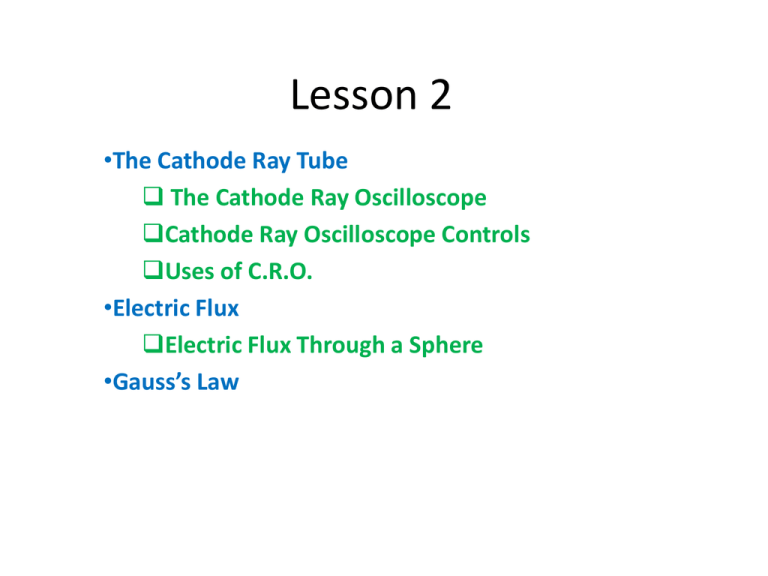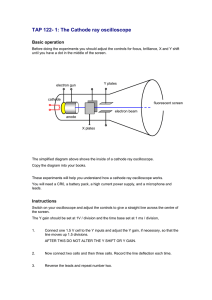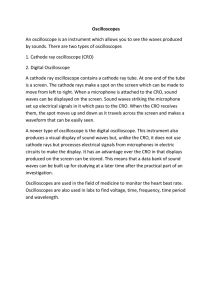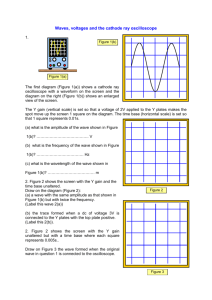The Cathode Ray Oscilloscope
advertisement

Lesson 2 •The Cathode Ray Tube The Cathode Ray Oscilloscope Cathode Ray Oscilloscope Controls Uses of C.R.O. •Electric Flux Electric Flux Through a Sphere •Gauss’s Law The Cathode Ray Tube • Example 7 on an accelerated electron (See lesson 1) describes a portion of a cathode ray tube (CRT). This tube, is commonly used to obtain a visual display of electronic information in oscilloscopes, radar systems, television receivers, and computer monitors. • The CRT is a vacuum tube in which a beam of electrons is accelerated and deflected under the influence of electric or magnetic fields. The electron beam is produced by an assembly called an electron gun located in the neck of the tube. • These electrons, if left undisturbed, travel in a straight-line path until they strike the front of the CRT, the “screen,’’ which is coated with a material that emits visible light when bombarded with electrons. The Cathode Ray Tube The Cathode Ray Tube The Cathode Ray Tube • The CRT is composed of two main parts, 1. 2. • Electron Gun Deflection System Electron Gun – – – Electron gun provides a sharply focused electron beam directed toward the fluorescent-coated screen. The thermally heated cathode emits electrons in many directions. The control grid provides an axial direction for the electron beam and controls the number and speed of electrons in the beam. The momentum of the electrons determines the intensity, or brightness, of the light emitted from the fluorescent coating due to the electron bombardment. Because electrons are negatively charged, a repulsion force is created by applying a negative voltage to the control grid, to adjust their number and speed. The Cathode Ray Tube – A more negative voltage results in less number of electrons in the beam and hence decreased brightness of the beam spot. Since the electron beam consists of many electrons, the beam tends to diverge. This is because the similar (negative) charges on the electrons repulse each other. To compensate for such repulsion forces, an adjustable electrostatic field is created between two cylindrical anodes, called the focusing anodes. The variable positive voltage on the second anode cylinder is therefore used to adjust the focus or sharpness of the bright spot. • The Deflection System – The deflection system consists of two pairs of parallel plates, referred to as the vertical and horizontal deflection plates. One of the plates in each set is permanently connected to the ground (zero volt), whereas the other plate of each set is connected to input signals or triggering signal of the CRO. Cathode Ray Oscilloscope Time base Display Y-gain Channel1 Channel 2 Cathode Ray Oscilloscope • A typical analogue oscilloscope Cathode Ray Oscilloscope Controls • Y-Gain – amplifies the Y-deflection – small input voltages are amplified by built-in amplifiers before applying to the Y-plates. – Y- Gain = 0.5 V/div • 0.5 volt will cause a vertical deflection of 1 division Cathode Ray Oscilloscope Controls Time Base • is a saw-tooth voltage applied internally across the X-plates. volts time Cathode Ray Oscilloscope Controls Time Base • controls the speed at which the spot sweeps across the screen horizontally from left to right. volts spot on right side of screen spot at centre of screen 0 Fly back time spot on left side of screen Time taken for spot to move across the screen and back Cathode Ray Oscilloscope Controls Time Base volts spot on right side of screen spot at centre of screen Fly back 0 time spot on left side of screen Screen Cathode Ray Oscilloscope Controls Time Base • it helps to display the actual waveform of any a.c. applied across the Y-plates • normally calibrated in – s/cm – ms/cm – s/cm • gives the time required for the spot to sweep 1 cm horizontally across the screen. Cathode Ray Oscilloscope Controls Time Base: How It Works volts spot on right side of screen spot at centre of screen spot on left side of screen B Fly back 0 A time C Time taken for spot to move across the screen and back Uses of C.R.O. 1. Display waveforms of alternating p. d. 2. Measure potential difference – d.c. – a.c. 3. Measurement of Frequency 4. Measurement of Phase Uses of C.R.O. Displaying a Voltage Waveform Peak-to-Peak voltage Time Period (ms) To get the time period you need to measure this distance and convert it to time by multiplying by the time base setting Uses of C.R.O. Displaying a Voltage Waveform Uses of C.R.O. Displaying a Voltage Waveform • Set the time-base to a suitable frequency, • Apply the input to the Y-plate – a steady waveform of the input will be displayed on the C.R.O. Uses of C.R.O. Measuring a Direct Current Voltage • • • • switch off the time-base a spot will be seen on the C.R.O. screen d.c. to be measured is applied to the Y-plates spot will either deflected upwards or downwards • deflection of the spot is proportional to the d.c. voltage applied Uses of C.R.O. Measuring a Direct Current Voltage • Set the VOLTS/DIV to 1 by adjusting the outer dial. • Turn the inner dial all the way to the right, which will put it in the calibrated position. • Switch the AC-GND-DC switch for channel 1 to DC. Uses of C.R.O. Measuring a Voltage as a Voltmeter • it has nearly infinite resistance (between the X- and Y-plates), therefore draws very little current; • it can be used to measure both d.c. and a.c. voltages; and • it has an immediate response. Uses of C.R.O. Measurement of Frequency Time Per Division Dial • The Time/Div dial on the oscilloscope controls the amount of time per centimeter division. • • • • A simple method of determining the frequency of a signal is to estimate its periodic time from the trace on the screen of a CRT. To calculate the frequency of the observed signal, one has to measure the period, i.e. the time taken for 1 complete cycle, using the calibrated sweep scale. The period could be calculated by T = ( no. of squares in cm) x ( selected Time/cm scale ) Once the period T is known, the frequency is given by f (Hz)= 1/T(sec) Uses of C.R.O. Example: Measurement of Frequency and a. c. voltage Using a CRO The total height of the wave from peak to trough is 6.4 cm Vpk to pk= 12.8 V V0 = 6.4 V 6.4 cm 1 cycle occupies 2.8 cm T = 1.40 ms = 1.40 10-3 s Frequency = 1 1.40 10-3 s = 714 Hz 2.8 cm The time base controls are set at 5 ms/cm The voltage gain is set at 2 V/cm Uses of C.R.O. •Measurement of Phase •The calibrated time scales can be used to calculate the phase shift between two sinusoidal signals of the same frequency. If a dual trace or beam CRO is available to display the two signals simultaneously ( one of the signals is used for synchronization), both of the signals will appear in proper time perspective and the amount of time difference between the waveforms can be measured. •This, in turn can be utilized to calculate the phase angle , between the two signals. Phase shift in cm. x 360 One period in cm. Uses of C.R.O. Measurement of Phase Phase shift in cm One period in cm Phase shift in cm. x 360 One period in cm. Uses of C.R.O. Lissajous’ Figures • Lissajous’ figure can be displayed by applying two a.c. signals simultaneously to the X-plates and Y-plates of an oscilloscope. • As the frequency, amplitude and phase difference are altered, different patterns are seen on the screen of the CRO. • Lissajous’ figures are obtained with an oscilloscope when this is operated in XY mode and when in both channel 1 and 2 voltages are applied. • If the ratio of the two frequencies of the voltages is just equal to a rational number, standing figures appear on the oscilloscope (Lissajous’ figures); if the frequency ratio, however, deviates slightly from a rational number, these figures are moving. • In this way it is possible to make small frequency differences visible and measurable. Unknown frequencies can be determined, if these are applied to one channel of the oscilloscope and are superimposed with a voltage of known, but adjustable frequency from a function generator applied to the other channel. Uses of C.R.O. • Use of Lissajous Patterns to Calculate Phase Shift – Lissajous patterns are obtained on the scope simultaneously by applying the two sinusoidal inputs to be compared at the vertical and horizontal channels. – The phase shift is then determined using measured values taken from resulting Lissajous pattern. This pattern on the CRT screen may be either a straight line or a circle or an ellipse depending on the amount of phase shift. Uses of C.R.O. Lissajous’ Figures Same amplitude but different frequencies





